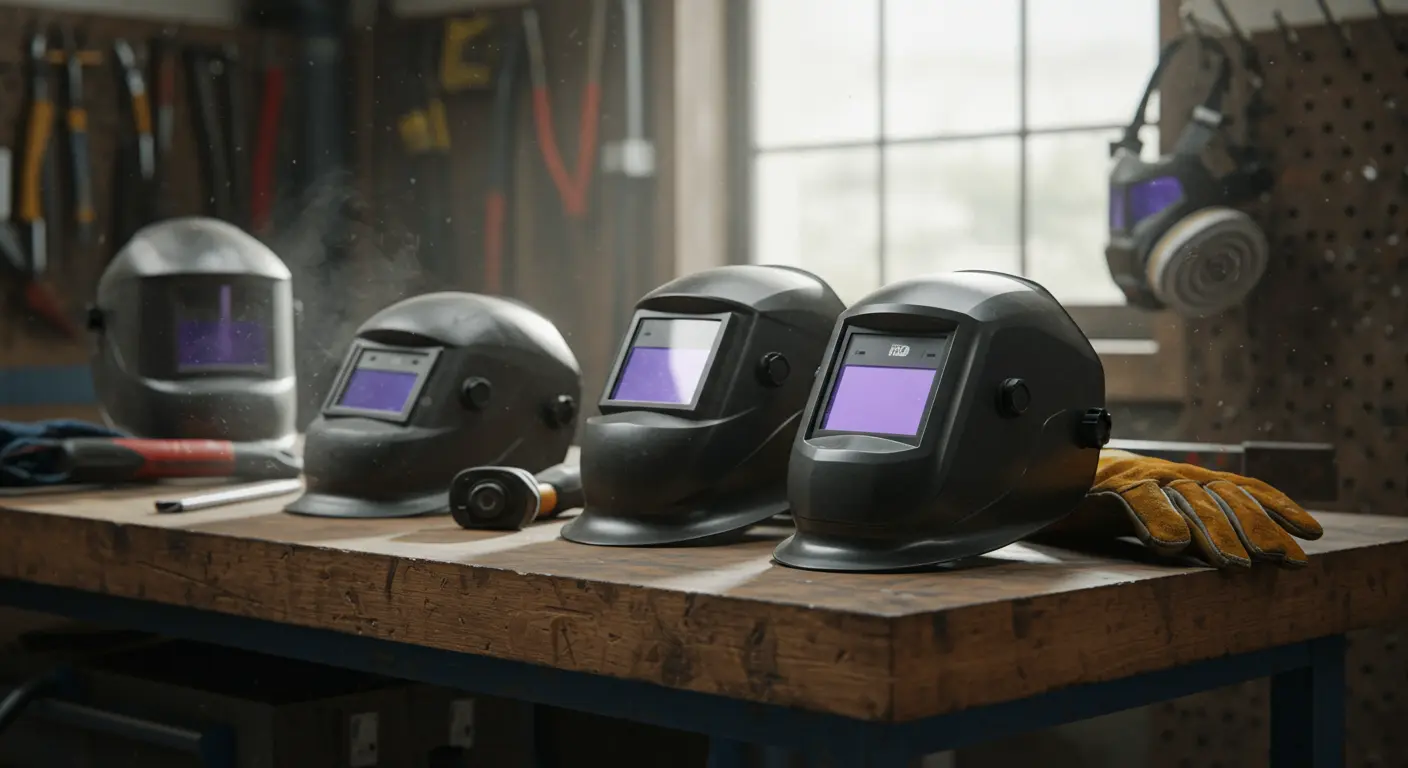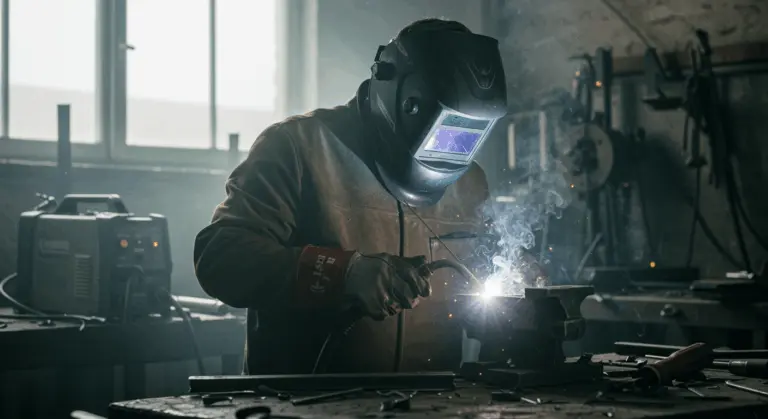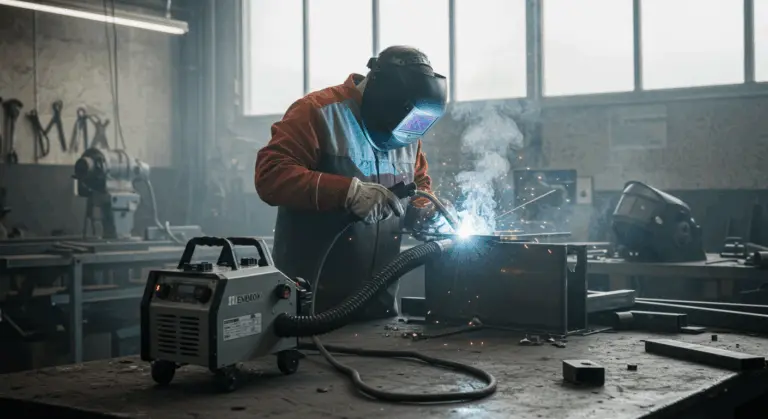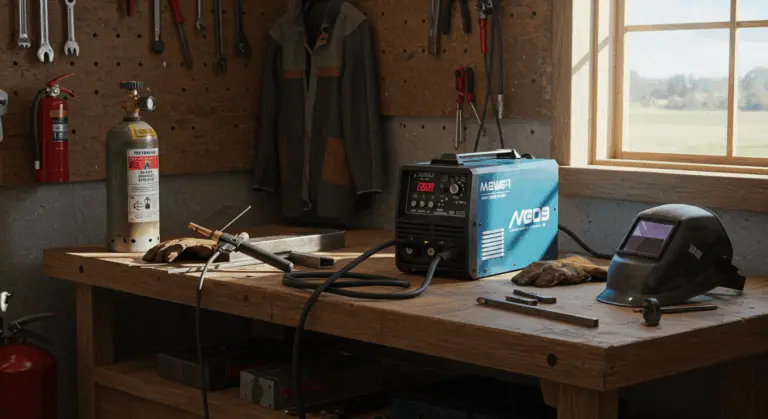Overview of Welding Hoods – Importance and Functionality
Welding hoods, also known as welding masks or helmets, serve as essential of personal protective equipment (PPE) for any welder. They serve as the main defense against numerous welding hazards, shielding the face, eyes, and neck from the intense ultraviolet (UV) and infrared (IR) radiation that emanates from the arc. Without this protection, welders face serious conditions like arc eye (photokeratitis) or devastating long-term damage such as cataracts.
Beyond radiation protection, welding hoods protect against flying sparks, molten metal splatter, and the searing heat generated during welding processes. What makes welding hoods effective is its specialized lens system—a delicate balance that allows welders to see their work clearly while filtering out harmful light. This equilibrium between visibility and protection makes welding hoods essential for both seasoned professionals and weekend hobbyists.
Modern welding hoods have evolved significantly from their rudimentary early designs. Today’s helmets incorporate advanced technologies that improve both safety and productivity. Understanding the diverse types available and their specific features is important for selecting the right protection for your welding applications.
Types of Welding Hoods Based on Functionality
Welding hoods fall into distinct categories based on their functionality, with each type delivering unique advantages tailored to specific applications and user preferences.
The fundamental distinction lies between passive and auto-darkening helmets. Passive helmets feature a fixed shade lens (typically #10) that provides consistent protection regardless of welding conditions. While affordable and dependable, they demand that welders constantly flip the helmet up and down between welds—a process that becomes cumbersome during frequent starts and stops.
Auto-darkening helmets offer significant technological improvements, automatically adjusting their shade the instant an arc is struck. This advancement enables welders to position their work with the helmet down, improving accuracy while reducing neck strain from repetitive helmet movements.
Beyond these main categories, specialized helmets address specific welding scenarios:
-
Pancake Helmets: Preferred by pipeline welders for their lightweight design and suitability for tight spaces.
-
Respirator Helmets: Integrate breathing protection to shield against hazardous fumes, ideal for poorly ventilated areas.
-
Multipurpose Helmets: Offer versatility by including a grinding mode, allowing users to switch tasks without removing the helmet.
Passive Welding Helmets – Fixed Shade Protection
Passive welding helmets embody the time-tested approach to welding protection, featuring a fixed shade lens that delivers consistent protection throughout the entire welding process. These helmets typically employ a #10 shade lens, though options spanning from #9 to #13 are available depending on the specific welding application and arc brightness.
The main advantages of passive helmets include simplicity, reliable performance, and budget-friendly pricing. Devoid of electronic components, they provide consistent protection without the risk of sensor malfunction or battery failure. This makes them a good choice for beginners, hobbyists, or as a dependable professional backup.
However, their main drawback is the fixed dark lens, which forces welders to constantly flip the helmet up and down. This repetitive motion can reduce productivity, trigger neck strain, and may not provide the best shade level for all welding processes.
Auto-Darkening Welding Helmets – Enhanced Safety
Auto-darkening welding helmets offer significant advances in welding safety technology. These sophisticated helmets feature specialized liquid crystal display (LCD) lenses that automatically transition from a light shade (typically #3 or #4) to a darker shade (usually between #9 and #13) within milliseconds of detecting the welding arc. This quick response provides continuous protection while improving workflow efficiency.
Their main advantage is hands-free operation. Welders can position their work with the helmet down, as the lens darkens automatically when the arc strikes. This enhancement improves weld quality, increases efficiency, and eliminates neck strain by removing the need to flip the helmet.
Auto-darkening helmets come in two main varieties:
-
Fixed Shade: The lens darkens to a single, predetermined shade (e.g., #10) when an arc is detected.
-
Variable Shade: Allows the welder to adjust the dark shade level (typically from #9 to #13) to match the specific welding process and amperage.
While auto-darkening helmets command a higher price than passive models, their enhanced safety features, improved productivity, and reduced physical strain make them the preferred choice for professional welders and serious enthusiasts. Most modern auto-darkening helmets also include adjustable sensitivity and delay settings, allowing welders to customize the helmet’s response to their specific working conditions.
Specialized Welding Helmets – Pancake and Respirator Types
Beyond standard passive and auto-darkening helmets, specialized welding helmets tackle unique welding scenarios and environmental challenges. Two standout specialized types are pancake helmets and respirator helmets, each engineered for specific applications in the welding industry.
Pancake welding helmets, aptly named for their flat, round profile, are preferred for pipeline welders. Their featherweight, minimalist design with a balsa wood interior excels in tight or awkward positions, providing a comfortable, fixed shield that enhances precision during marathon welding sessions.
Respirator welding helmets combine respiratory protection with traditional welding shields, addressing health concerns associated with welding fumes and particulates. These comprehensive protection systems combine a welding lens with powered air purifying respirators (PAPER) that filter ambient air before delivering it to the welder’s breathing zone.
Other specialized types include:
-
Underwater Helmets: Designed specifically for marine welding applications.
-
Smart Helmets: Equipped with digital features like Bluetooth, cameras, and mobile app integration for advanced control and monitoring.
Welding Helmet Features – What to Look For
When evaluating welding helmets, several critical features directly impact both safety and usability. Knowing these features helps welders to select the perfect helmet for their specific needs and working conditions.
Viewing area size is an important factor that affects visibility and precision. Larger viewing areas, typically ranging from 3.5 to 6 square inches, provide an expansive field of vision, allowing welders to see more of their workpiece and surrounding area. While larger viewing windows offer superior visibility, they can add weight to the helmet. Smaller viewing areas provide more focused vision and typically come in lighter helmets, which may be preferable for extended use.
Optical clarity is rated on a 1/1/1/1 scale, with 1 being the best score in each of the following categories:
-
Optical Class (Accuracy of Vision)
-
Light Diffusion (Clarity of Lens)
-
Luminous Transmittance (Uniformity of Shade)
-
Angle Dependence (Consistent Shade from all Angles)
A higher rating (e.g., 1/1/1/1) reduces eye strain and provides a clearer view of the weld puddle.
Reaction time measures how quickly an auto-darkening lens transitions from light to dark when an arc is struck. Professional-grade helmets have reaction times as fast as 1/20,000 of a second, providing virtually instantaneous protection. Fast reaction times are especially important for TIG welding and other precision applications.
Key additional features to consider include:
-
Grind Mode: Allows switching to a clear state for grinding without removing the helmet.
-
Headgear: Look for multiple adjustment points for a comfortable, secure fit.
-
Power Source: Options include replaceable batteries, rechargeable batteries, and solar-assist panels.
-
Smart Features: High-end helmets may offer Bluetooth connectivity, digital controls, and built-in cameras.
Materials Used in Welding Helmets – Durability and Weight
The materials used in welding helmet construction significantly affect their durability, weight, heat resistance, and ultimately, user comfort during extended welding sessions. Modern welding helmets are typically crafted from one of three primary materials: ABS plastic, fiberglass, or carbon fiber.
| Material | Key Characteristics | Best For |
|—|—|—|
| ABS Plastic | Lightweight, affordable, lower heat resistance. | Hobbyists, beginners, and light-duty applications. |
| Fiberglass | Excellent heat resistance and durability, heavier than ABS. | Professional welders and high-heat, heavy-duty tasks. |
| Carbon Fiber | Premium strength-to-weight ratio, extremely lightweight and durable. | Professionals requiring maximum comfort for all-day use. |
When selecting a welding helmet based on material, welders should consider their specific application requirements, working environment, and frequency of use to determine which material provides the best balance of protection, comfort, and value for their particular needs.
Safety Standards for Welding Helmets – ANSI and CSA Compliance
Welding helmets must meet stringent safety standards to ensure they provide adequate protection against the various hazards associated with welding operations. In North America, two primary regulatory bodies establish these standards: the American National Standards Institute (ANSI) in the United States and the Canadian Standards Association (CSA) in Canada.
In the United States, welding helmets must comply with ANSI Z87.1, which establishes rigorous requirements for eye and face protection devices. This standard specifies minimum lens shade requirements for different welding processes, impact resistance criteria, and optical clarity standards.
Canadian welders should look for CSA Z94.3 compliance, which is the Canadian equivalent standard for eye and face protectors. Similar to ANSI, this standard establishes requirements for optical quality, impact resistance, and appropriate shade levels for various welding processes. While there are many similarities between ANSI and CSA standards, there are some differences in testing methodologies and specific requirements.
When purchasing a welding helmet, look for clear markings indicating compliance with these standards. Reputable manufacturers will prominently display ANSI Z87.1 or CSA Z94.3 certification on their packaging and the helmet itself. Some helmets meet both standards, making them suitable for use in both countries. Don’t compromise on safety—avoid welding helmets that don’t meet these standards, as non-compliant helmets may fail to provide adequate protection against radiation, impact, or other welding hazards.
Premium helmets may also meet other international standards, providing further assurance of quality:
-
CE Certification: European standards.
-
AS/NHS: Australian/New Zealand standards.
Choosing the Right Welding Hood – A Buying Guide
Selecting the ideal welding hood requires careful consideration of several factors, including your specific welding processes, work environment, frequency of use, and personal preferences. This guide covers the key decision points to find the perfect helmet for your needs.
Match the helmet to your primary welding process:
-
TIG Welding: Requires high optical clarity and a large viewing area for precision.
-
MIG Welding: Benefits from a variable shade range to handle brighter arcs.
-
Stick Welding: Demands a durable helmet with excellent heat resistance to withstand sparks and spatter.
Next, consider your work patterns. If you frequently start and stop welding or change positions, an auto-darkening helmet will improve your efficiency and comfort by eliminating the need to repeatedly flip your helmet up and down. For continuous welding in a fixed position, a passive helmet might suffice and prove more economical.
Evaluate your work environment:
-
Outdoors: A solar-powered helmet offers reliable operation.
-
Confined Spaces: A lightweight, low-profile helmet like a pancake model is ideal.
-
Poor Ventilation: A respirator helmet (PAPER) is essential for protection against hazardous fumes.
Don’t overlook the importance of comfort features, especially if you weld for extended periods. Adjustable headgear with multiple points of customization, balanced weight distribution, and adequate padding can significantly reduce fatigue. Some helmets also offer features like sweatbands and ergonomic designs specifically engineered for all-day comfort.
Finally, match features to your workflow demands. A dedicated grind mode is very useful if you often switch between tasks, while smart helmets with cameras can benefit professionals who need to document or share their work.
Evaluating Helmet Comfort and Fit
Comfort and proper fit are crucial aspects of welding helmet selection that directly impact both safety and productivity. A well-fitting helmet ensures consistent protection while minimizing physical strain during extended welding sessions. When evaluating helmet comfort and fit, several key factors should be carefully considered.
Headgear is the most important comfort element. Look for multiple adjustment points that enable a custom fit:
Weight distribution significantly affects comfort during extended use. A well-engineered helmet distributes weight evenly across the head rather than concentrating it at the front, which can trigger neck strain. Lighter materials like carbon fiber reduce overall weight, but balance is equally important. When trying on helmets, perform a full range of head movements to assess how the helmet feels in different positions.
Padding quality and placement are important for comfort where the helmet contacts your head. Seek moisture-wicking materials that remain comfortable in sweltering conditions and sufficient padding thickness at pressure points. Removable, washable padding offers hygiene benefits for helmets used regularly.
The helmet’s center of gravity affects how it feels during use. Helmets with the lens positioned closer to your face generally feel more balanced than those with the lens extended further forward. This positioning also impacts your field of vision and the helmet’s tendency to lift or shift during movement.
When possible, try on helmets before purchasing or ensure the retailer offers a generous return policy. A helmet that feels comfortable for a few minutes in a store might reveal pressure points or balance issues during a full day of welding. Keep in mind: even the most advanced features won’t compensate for poor fit—a comfortable helmet is one you’ll wear consistently, ensuring maximum protection for every welding task.
Understanding Price Ranges for Welding Helmets
Welding helmet prices span a dramatic range, from basic models under $50 to premium options exceeding $1,000. Knowing what causes these price differences helps welders to make informed decisions based on their specific needs and budget constraints.
| Price Range | Key Features | Best For |
|—|—|—|
| Entry-Level ($30-$100) | Passive lenses or basic auto-darkening with fewer sensors and smaller viewing areas. | Hobbyists, DIY tasks, or as a backup helmet. |
| Mid-Range ($100-$250) | Quality auto-darkening with multiple sensors, variable shades, grind mode, and better headgear. | Serious hobbyists and most professional welders. |
| Premium ($250-$500+) | Top-tier optical clarity (1/1/1/1), large viewing areas, fast reaction times, and lightweight materials like carbon fiber. | Full-time professionals requiring maximum performance and comfort. |
| Specialty ($500-$1,000+) | Integrated systems like Powered Air-Purifying Respirators (PAPER) or smart features like Bluetooth and cameras. | Specific industrial applications or users with advanced safety and technology needs. |
Key Takeaways – Summary of Welding Hood Types
Welding hoods come in several distinct categories, each designed to address specific welding scenarios and user preferences. Knowing these types helps welders to make informed decisions when selecting the appropriate protection for their work.
-
Passive Helmets: Affordable and reliable with a fixed shade lens. They require no batteries but must be manually flipped up and down, which can slow workflow and cause neck strain.
-
Auto-Darkening Helmets: Automatically darken when an arc is struck, improving efficiency, accuracy, and comfort. They are the standard for most professionals due to their hands-free operation.
-
Specialized Helmets: Designed for specific needs, such as lightweight pancake helmets for pipeline work or respirator helmets that integrate air purification for hazardous environments.
-
Multipurpose Helmets: Offer versatility with features like a dedicated grinding mode, allowing users to switch tasks without removing the helmet, which is ideal for fabrication work.





